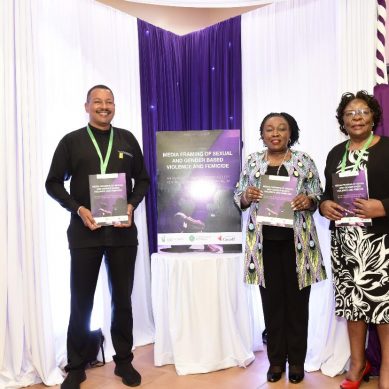
There is a new phenomenon in the global arena: environmental refugees. These are people who can no longer gain a secure livelihood in their homelands because of drought, soil erosion, desertification, deforestation and other environmental problems, together with the associated problems of population pressures and profound poverty or due to political violence and instability, according to environmentalist Myers.
In 1995, the late Professors Foster Byarugaba, previously head of the Department of Political Science and Public Administration of Makerere University, Uganda, and I wrote a book titled Environmental Refugees in Africa: Suggestions for Future Actions. It was published by the Department of Political Science and Public Administration, Makerere University, the same year. It was based on a joint paper by the same title that I presented at an expert consultation, The Environmental Impact of Sudden Population Displacements: Priority Policy Issues and Humanitarian Ai, organised by Centre for Research on the Epidemiology of Disasters (CRED) at Universite Catholique de Louvain, Brussels, Belgium, and sponsored by the European Commission Humanitarian Aid Office (ECHO) in 1995.
Sometimes environmental refugees have been reduced to just climate refugees. Climate refugees are people who must leave their homes and communities because of the effects of climate change and global warming. However, climate refugees are really a category of environmental refugees that are forced to migrate as a result of decay and collapse in the various dimensions of the environment – the ecological biological, the socioeconomic and the socio-cultural (which includes the sociopolitical aspect). Many times, the problem of migrant refugees is caused by failure to apply correct timescales to processes in the environment, leading to decay and collapse in the various dimensions of the environment.
In fact, a time or temporal dimension of the environment does exist so that we can talk of four dimensions of the environment (the ecological-biological, the socioeconomic, the sociocultural and the temporal). However, the dimensions are not mutually exclusive but are mutually inclusive. Some causes of refugee migrations are a result of interactions of the phenomena occurring in the dimensions of the environment.
Therefore, it is better to be broad in thinking and reasoning and take climate migrants or climate refugees as environmental refugees mainly originating in the ecological-biological dimension but confounded by phenomena in the socioeconomic and sociocultural dimensions, including the sociopolitical. In the sociopolitical perspective, certain choices of the rulers are enough to initiate displacements of populations by converting them into environmental refugees.
In our little book Environmental refugees in Africa: Some Suggestions for Future Actions, we concentrate on the Rwandese Hutu refugee malaise in the Democratic Republic of Congo (then called Zaire) from 1994, when rebel Tutsi refugees from Uganda captured the instruments of power from the Hutu regime of Juvenal Byarugaba. The Hutu refugee malaise was occasioned by the socio-political decay and collapse that followed the political military excesses and reprisals reigned upon the Hutus by the Tutsis in power and their supporters.
It was a reversal of the aftermath of the Hutu uprising against the Tutsi in the late 1950s. Thus the Hutu refugees that flocked into the forests of Zaire (Democratic Republic of Congo) were not climate refugees but environmental refugees that were forced to flee Rwanda by the sociopolitical changes in Kigali and Rwanda with the capture of the instruments of power in Kigali.
It should be remembered that the rebel group that captured power in Kigali as Rwandese Patriotic Front/Army (RPF/A) was formed with in the National Resistance Movement/A (NRM/A) during its insurgency in Uganda from 1981-1986. Some critical thinkers argue that before President Tibuhaburwa Museveni agreed to merge his Patriotic Resistance Army (PRA) with Professor Yusuf Lule’s Uganda Freedom Fighters (UFF) the PRA was a Rwandese Tutsi refugee outfit that went wholesale into the new NRM and retained its identity, finally splitting into two – one that remained in Uganda to take forward what was called a revolution in Kampala and the other that raided Rwanda as RPF/A and captured the instruments of power in Kigali. One can say that the NRM/A and RPF/A were socio-politically organised environmental refugees that captured power first in Uganda and then in Rwanda.
Indeed, one school of thought argues that the environmental refugees of Uganda have retained power for over 38 years and have strategised to exclude the indigenes from accessing power well in the future. Likewise, the environmental refuges that emerged as RPF/A in Rwanda and captured the instruments of power in Kigali have strategised to conquer the Hutu and exclude them from power well in future.
Therefore, environmental refugees can destroy the independence, citizenship and sovereignty of a people. The socioeconomic refugees from Europe more than 350 years ago occupied and conquered the Maoris of Ne Zealand, the Aboriginals of Australia and the Red Indians of South America and North America, and destroyed their sociocultural independence, citizenship and sovereignty. Their identities and belonging have been reduced to insignificance. Their ecological-biological, socioeconomic and sociocultural dimensions of the environment are now possessions of people from elsewhere. People from elsewhere are the ones that produce ministers, prime ministers, presidents and executives of the institutions of state in those places.
A country is lucky if environmental refugees capture the instruments of power and everything in it and they promote culturally responsive education, education for sustainability, equality, science for survival, ecological science for all, especially the leaders and policy-makers, science as one (natural science, humanities and social science), environmental security, political democracy, environmental democracy, ecological democracy, social democracy, economic democracy, cultural democracy, academic democracy, intellectual democracy, educational democracy, health democracy, seed democracy, scientific democracy, spiritual democracy.
Climate justice, environmental justice, environmental cooperation, environmental peace, environmental diplomacy, the negotiated approach to everything (including law-making, policy making and governance), All these were violated during apartheid in South Africa, and are violated by apartheid-like regimes of environmental refugees in power.
In the little book by Foster Byarugaba and Oweyegha-Afunaduula, we surmised that despotic regimes produce environmental refugees, that may be referred to as cross-border refugees or internal refugees in their homeland, military, economic and social policies. Sometimes the regime in Uganda has been referred to as authoritarian or despotic. There is no doubt that its policies have caused many Ugandans to flee to foreign countries as environmental refugees to make ends meet. We now know that many Ugandans working abroad send a lot of money to Uganda far in excess of money being received by the Uganda government as donor money or foreign aid.
Others are those who have been ferried out of the country to the Middle East to work as external slaves. They ferry in a lot of money which government benefits from. Instead of calling them slaves, we might call them environmental refugees instead. Their rising numbers reflect ecological-biological, socioeconomical and sociopolitical decay and collapse in Uganda. As expected, the majority are young people, who would otherwise contribute to the rise in the population of the indigenes if they stayed in their country to marry and get children.
What is worrying indigenous Ugandans are the rising population of cross-border refugees from countries with significant Cushite populations such as Burundi, Rwanda, Ethiopia, South Sudan and Eritrea. The soft spot exhibited by the NRM government towards those refugees has pushed some Ugandans to suspect that the government has strategised to let so man Cushites to enter Uganda and swell the number of Cushites composed by immigrant Tutsis and the Hima. Another worry is that as the quality of education and government commitment to the education of Ugandan children plummet, the NRM government has committed large sums of public money to the education of Cushite immigrants who keep on entering Uganda. One school of thought believes the NRM government is encouraging the Cushite immigrants to enter Uganda for monetary benefits.
Uganda stands out as the leading receptacle of immigrant refugees in Africa and the whole world. One school of thought argues that this is not surprising because the dominant rulers of Uganda are Cushites. Researchers will need to delve into the current environmental refugees entering Uganda and their impact on the indigenes and their ecological-biological, socio-economic and socio-cultural systems.
Already there is concern among the indigenes that people of Cushite blood – usually called nomadic pastoralists – have extensively grabbed land and greens virtually everywhere in Uganda. They have destroyed agroecological systems and sacred areas. They have even invaded lakes and excluded traditional fisherfolk from fishing, with the full knowledge and acquiescence of the politico-military regime in power.
As if this is not bad enough, indigenes were constitutionally excluded from their natural resources underground, which were placed in the hands of President Tibuhaburwa Museveni. There are no clear arrangements to enable the indigenes to benefit from their natural wealth. A good example is the subregion of Busoga, which has been established to be very rich in gold and rare minerals.
Instead, the Basoga have been encouraged to grow sugarcane, oil palm and food for those who will work in the mines sector. This, one school of thought, is the price of power being concentrated in the hands of environmental refugees. Of course, we need thorough research to link environmental refugees with the exclusion of the indigenes of Busoga from their natural resources.
In summary, there is a scourge of environmental refugees in Uganda. They have occupied and captured everything in the country, excluded the indigenes from resources and power, and promise to capture the citizenship and sovereignty of the country for their benefit. Fortunate for them most Ugandans, both in government and outside government, are unaware of what waits for them to face: total dispossession and displacement by the environmental refugees in and outside power.
What is evident on the ground is that locally environmental exodus (e.g., Myers and Kent, 1995) is proliferating in most parts of Uganda due to environmental decay and collapse precipitated by the environmental refugees in and outside power. The indigenes must wake up to their new reality. Later will be too late.
Besides, researchers in Uganda today need to create research topics in the area of Refugees, host communities and the environment. Uganda may soon be overwhelmed by environmental refugees in every sector of the economy and in governance.
For God and my country.
- Tell report / By Oweyegha-Afunaduula / Environmental Historian and Conservationist Centre for Critical Thinking and Alternative Analysis (CCTAA), Seeta, Mukono, Uganda.
About the Centre for Critical Thinking and Alternative Analysis (CCTAA)
The CCTAA was innovated by Hyuha Mukwanason, Oweyegha-Afunaduula and Mahir Balunywa in 2019 to the rising decline in the capacity of graduates in Uganda and beyond to engage in critical thinking and reason coherently besides excellence in academics and academic production. The three scholars were convinced that after academic achievement the world outside the ivory tower needed graduates that can think critically and reason coherently towards making society and the environment better for human gratification. They reasoned between themselves and reached the conclusion that disciplinary education did not only narrow the thinking and reasoning of those exposed to it but restricted the opportunity to excel in critical thinking and reasoning, which are the ultimate aim of education. They were dismayed by the truism that the products of disciplinary education find it difficult to tick outside the boundaries of their disciplines; that when they provide solutions to problems that do not recognise the artificial boundaries between knowledges, their solutions become the new problems. They decided that the answer was a new and different medium of learning and innovating, which they characterised as “The Centre for Critical Thinking and Alternative Analysis” (CCTAA)
Further reading
Aidez (2024). How Does Climate Change Affect Migration in Africa? February 16 2024. https://aideznousaaider.com/2024/02/how-does-climate-change-affect-migration-in-africa/?gad_source=1&gclid=Cj0KCQiA88a5BhDPARIsAFj595ghG_NOfZmH-Jyy0NplyKvQJ3nyQgVrsHQ4KHQntybd9bCYoiKl9IkaAjDkEALw_wcB Visited on 11 November 2024 at 18.21pm EAT.
Bates, Diane C. (2002). Environmental Refugees? Classifying Human Migrations Caused by Environmental Change Population and Environment Vol, pp. 465-477 (13 pages) Published By: Springer Nature. https://www.jstor.org/stable/27503806 Visited on 11 November 2024 at 1848pm EAT
Bireme (?). The Environmental Impact of Refugees in Africa. http://cidbimena.bvs.hn/docum/crid/Enero2005/CD2/pdf/eng/doc10049/doc10049-d.pdf Visited on 11 November 2024 at 17.18 pm EAT.
Byarugaba Fister and F.C. Oweyegha-Afunaduula (1995). Environmental Impact of Refugees in Africa: Some Suggestions for Future Actions. Department of Political Science and Public Administration, Makerere University, 1995 (Publisher). 63 pages.
Climate and Migration Coalition (?). Environmental Refugees: Who are they, Definition and Numbers. https://climatemigration.org.uk/environmental-refugees-definition-numbers/ Visited on 11 November 2024 at 1842pm EAT
Concern Worldwide US (2022). Climate Refugees: The World’s Forgotten Displacement Crisis. April 5 2022.
El-Hinnawi, E. (1985). Environmental Refugees. Nairobi: United Nations Environment Programme.
Byarugaba Foster and Oweyegha-Afunaduula, F. C. (1995). Environmental Impact of Refugees in Africa: Some Suggestions for Future Actions. IN: CRED Universite Catholique de Louvain Expert Consultation “The Environmental Impact of Sudden Population Displacements: Priority Policy Issues and Humanitarian Aid” sponsored by ECHO, page 52-73. http://cidbimena.bvs.hn/docum/crid/Enero2005/CD2/pdf/eng/doc10049/doc10049-a.pdf Visited on 11 November 2024 at 18.15 pm EAT.
Keyes, Elizabeth (2019). Environmental Refugees? Rethinking What’s in a Name? 44 North Carolina Journal of International Law 461 (2019). Available at: https://scholarworks.law.ubalt.edu/all_fac/1082 https://scholarworks.law.ubalt.edu/all_fac/1082/ Visited on November 2024.at 18.34 pm EAT
Kibreab, Gaim (1994). “Migration, environment and refugeehood”. In: Zaba, B. and Clarke. J. (eds.) Environment and Population Change, Liège, Belgium: International Union for the Scientific Study of Population, Derouaux Ordina Editions, 115-29.
Kibreab, Gaim (1997). “Environmental causes and impact of refugee movements: a critique of the current debate”, Disasters 21(1): 20-38.
Myers, Norman (1993c). “Environmental refugees in a globally warmed world”, Bioscience, 43: 752-61.
Myers, Norman and Kent, J. (1995). Environmental Exodus: an Emergent Crisis in the Global Arena, Washington, DC: The Climate Institute
Norman Myers (2002). Environmental refugees: a growing phenomenon of the 21st century. National Library of Medicine, April 29 2002, https://pmc.ncbi.nlm.nih.gov/articles/PMC1692964/ Visited on 17. 47 pm EAT
Oweyegha-Afunaduula (2022). How Refugees and Former Refugees are Destroying the Environment in Uganda. IN: The Kampal Report, November 30, 2022 https://www.thekampalareport.com/talk-back/2022113021674/how-refugees(?)> -and-former-refugees-are-destroying-the-environment-in-uganda.html Visited on 11 November 2024 at 17.12 pm EAT.
Oweyegha-afunaduula (2023). The Refugee Malaise and the Futurity of Uganda. In: Uganda Today, December 14 2023. https://ugandatoday.co.ug/the-refugee-malaise-and-the-futurity-of-uganda/ Visited on 11 November 2024 at 17.0qpm EAT.
Richard Black (2001). Environmental refugees: myth or reality? New Issues in Refugee Research, Working Paper No. 34. University of Sussex
UNHCR The UN Refugee Agency (?). Refugees, host communities and the environment: A study on the impact of settling refugees in refugee hosting areas in Uganda. https://www.google.com/search?q=oweyegha-afunaduula%2Bfoster+byarugaba%2Benvironmental+refugees&sca_esv=a07f0383584960a3&sxsrf=ADLYWIJRaN5R2Hk06aiozDsx1OKkC3PhOQ:1731333226810&ei=agwyZ6OPMaqwi-gPrOeogAY&start=10&sa=N&sstk=ATObxK5m14RmbTnCILgO249HDSxesel8cYXCTzwNPnVeTB-XPkgEFKGb7a1bEndXbYVwAROJLaEkWuRPvhszb0dOLkgImOh91X8sXw&ved=2ahUKEwij7OLvttSJAxUq2AIHHawzCmAQ8tMDegQICBAE&biw=1360&bih=641 Visited on 11 November 2024 at 17.25pm EAT







